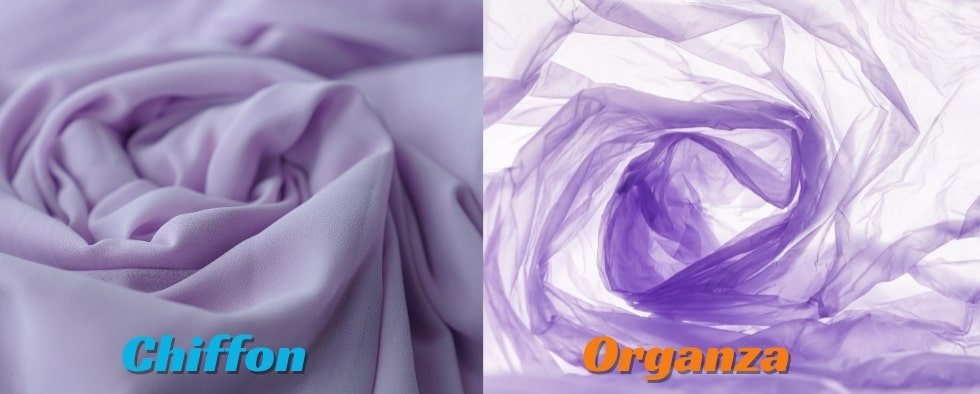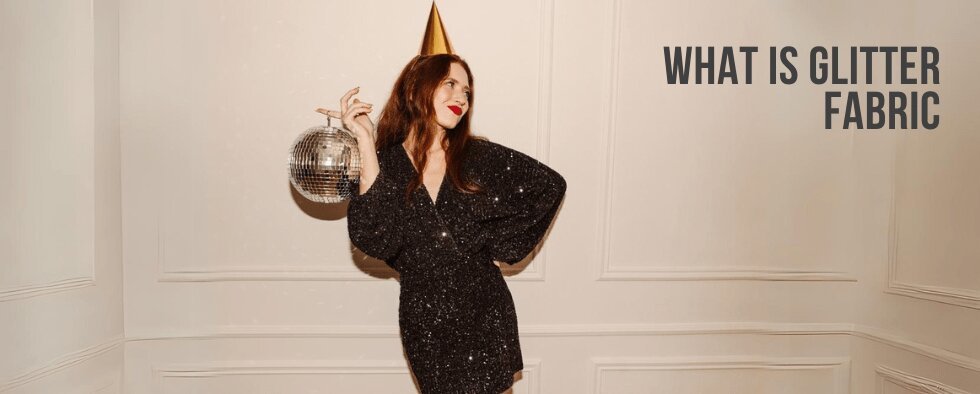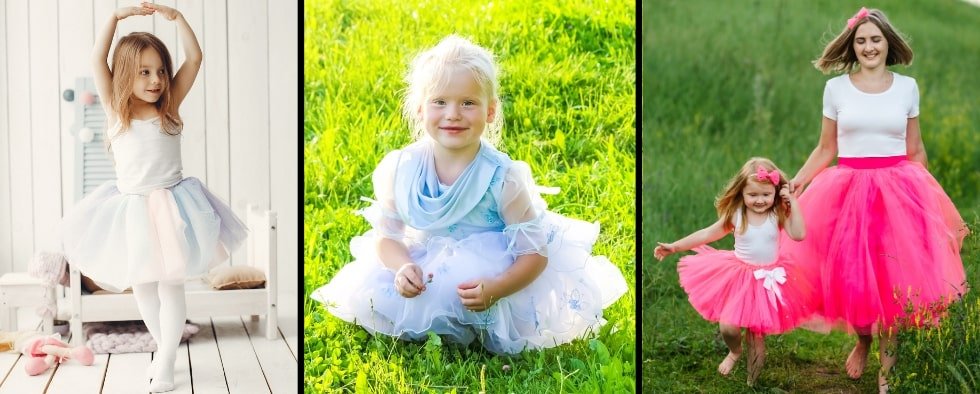Once you've said yes to the wedding proposal you've always wanted to have a beautiful dress Deciding what fabric to wear on your unique wedding dress. Both are suitable to work with and you likely will look gorgeous in both. However, choosing the appropriate fabric can be quite difficult.
The main difference lies with the textures. Organza is stiffer than chiffon and doesn't flow as well. This is fine for those who prefer a more formal wedding gown, but not suitable for those who prefer their dress to flow. Chiffon is a bit shiny to it, while organza has generally a more matt style.
Both fabrics have their unique characteristics, bringing distinct textures and drapes to the world of fashion.
Here we will discuss the differences between organza and chiffon and its features.
What is Organza and Why is it So Expensive?
Organza is a sheer and lightweight fabric known for its crisp and smooth texture. Typically made from silk, organza can also be crafted from synthetic or semi-synthetic fibers. The fabric's transparent appearance, coupled with a stiff and slightly rough feel, adds an element of sophistication to dresses and formal wear.
The benefits of organza fabric lie in its ability to hold its shape, making it ideal for garments that require structure and volume. Wedding dresses, evening gowns, and intricate overlays often feature organza due to its luxurious appearance and ability to enhance the overall silhouette. However, the question remains: why is organza so expensive?
The cost of organza can be attributed to the intricate manufacturing process and the quality of the material used. Authentic silk organza, in particular, involves the cultivation of silk-producing silkworms, careful extraction of silk threads, and precise weaving techniques. The craftsmanship required contributes to the fabric's elevated price point.
Is Organza Better than Chiffon?
The choice between organza and chiffon depends on the specific requirements of the garment and the desired aesthetic. Each fabric offers a unique set of characteristics that caters to different preferences.
Organza is revered for its stiffness, creating a structured and voluminous appearance. The fabric's ability to hold intricate shapes and designs makes it a preferred choice for garments where form and structure are essential. Wedding dresses, ball gowns, and couture pieces often feature organza to achieve a dramatic and elegant effect.
On the other hand, chiffon is celebrated for its soft, flowing, and lightweight nature. Made from silk, polyester, or a blend of both, chiffon drapes beautifully and adds a touch of romance to any garment. Chiffon is favored for its airy and ethereal quality, making it an excellent choice for flowing dresses, scarves, and overlays.
Ultimately, the decision between organza and chiffon depends on the desired aesthetic, the level of structure needed, and the overall vibe of the garment.
Chiffon is a lightweight, sheer fabric known for its fine, tightly twisted yarns. The material is crafted from silk, polyester, or a blend of both, imparting a delicate and airy quality. Chiffon's popularity stems from its ability to create soft and flowing silhouettes, making it a go-to choice for romantic and dreamy designs.
In terms of texture, chiffon boasts a luxurious and silky smooth feel. The fine and delicate nature of silk fibers contributes to the fabric's exceptional softness, offering a delightful experience against the skin. Chiffon's lightweight drape and gentle movement make it a favorite for garments that require fluidity and grace.
Organza vs. Chiffon
Fabric Type
Organza
Organza is a sheer and lightweight fabric known for its crisp and stiff texture. It is typically made from synthetic or semi-synthetic fibers such as polyester or nylon, although silk organza is also available. The fabric is woven in a plain weave structure, creating a transparent and airy material that is perfect for adding volume and structure to garments.
Chiffon
Chiffon, on the other hand, is a lightweight and sheer fabric with a soft and flowing texture. It is commonly made from silk, although polyester chiffon is also popular due to its affordability. Chiffon is woven in a more loose and balanced plain weave, resulting in a delicate and drapey fabric that is often used for flowing dresses, scarves, and bridal veils.
Texture
Organza
Organza has a slightly rough and stiff feel. The synthetic or semi-synthetic fibers used in its construction give it a firmer texture compared to silk. While not as soft as silk, organza still has a distinct texture that adds interest to garments.
Chiffon
Chiffon, on the other hand, has a luxurious and silky smooth feel that is highly sought after. The fine and delicate nature of silk fibers creates a fabric that is exceptionally soft and pleasant to touch. The smooth texture of silk adds to its overall comfort, making it delightful to wear against the skin.
Durability
Organza
Organza is known for its durability and strength. The tight weave structure of organza makes it resistant to tearing and fraying, ensuring that garments made from this fabric maintain their shape and integrity over time.
Chiffon
Chiffon, while delicate and lightweight, is less durable compared to organza. The loose weave structure of chiffon makes it more prone to snagging and tearing, especially in high-stress areas such as seams and hems. Careful handling and proper care are essential to prolonging the lifespan of chiffon garments.
Breathability
Organza
Organza is highly breathable due to its sheer and lightweight nature. The open weave structure allows air to circulate freely, making it an ideal choice for warm weather garments and accessories.
Chiffon
Chiffon is also breathable, although it tends to be slightly less airy compared to organza. The fine and lightweight nature of chiffon still allows for adequate airflow, making it suitable for wearing in various climates.
Wrinkle Resistance
Organza
Organza has moderate wrinkle resistance, meaning it may crease easily but can also be pressed back into shape with a low-heat iron or steamer. However, excessive folding or crumpling may result in stubborn wrinkles that are difficult to remove.
Chiffon
Chiffon is known for its tendency to wrinkle easily. The delicate and lightweight nature of chiffon makes it susceptible to creasing, especially when stored or transported improperly. Gentle steaming or ironing on a low heat setting is often required to remove wrinkles from chiffon garments.
Structure
Organza
Organza has a structured and firm drape, making it ideal for creating voluminous silhouettes and structured designs. The crisp texture of organza holds its shape well, allowing for the creation of dramatic and sculptural garments.
Chiffon
Chiffon has a soft and flowing drape that drapes beautifully against the body. The lightweight and airy nature of chiffon creates a fluid and ethereal effect, perfect for flowing dresses, skirts, and blouses.
Transparency
Organza
Organza is transparent, allowing light to pass through the fabric. While not completely sheer, organza has a semi-transparent quality that adds a delicate and ethereal touch to garments.
Chiffon
Chiffon is also transparent, although it tends to be slightly more opaque compared to organza. The sheer quality of chiffon creates a soft and romantic aesthetic, perfect for layering and overlaying in garments.
Colors
Organza
Organza is available in a wide range of colors, from vibrant hues to subtle pastels. The semi-transparent nature of organza enhances the depth and richness of color, making it a versatile choice for a variety of designs.
Chiffon
Chiffon is also available in an array of colors, ranging from bold and vibrant tones to soft and muted shades. The sheer quality of chiffon adds dimension and depth to the colors, creating a romantic and whimsical feel.
Cost
Organza
Organza is typically more expensive compared to chiffon, especially if made from silk. The high-quality fibers and intricate weaving process contribute to the higher cost of organza fabric.
Chiffon
Chiffon is generally more affordable compared to organza, especially if made from polyester. While silk chiffon may be pricier, polyester chiffon offers a more budget-friendly option without compromising on quality.
Maintenance
Organza
Organza requires careful handling and maintenance to preserve its crisp texture and structural integrity. Dry cleaning is often recommended for organza garments to avoid damage from washing and drying.
Chiffon
Chiffon also requires gentle care and maintenance to prevent snagging and tearing. Hand washing in cold water with a mild detergent is recommended for chiffon garments, followed by air drying or low-heat ironing.
Allergenic
Organza
Organza made from synthetic fibers such as polyester may be less allergenic compared to silk organza. However, individuals with sensitive skin or allergies may still experience irritation from prolonged contact with organza fabric.
Chiffon
Chiffon made from natural fibers such as silk may be more allergenic compared to polyester chiffon. While silk chiffon is less likely to cause skin irritation, individuals with allergies or sensitivities should exercise caution when wearing chiffon garments.
Climate Suitability
Organza
Organza is suitable for wearing in various climates, although its lightweight and breathable nature make it ideal for warm weather conditions. The airy texture of organza allows for adequate airflow, keeping the wearer cool and comfortable.
Chiffon
Chiffon is also suitable for wearing in different climates, although it may provide less insulation compared to organza. The lightweight and sheer nature of chiffon make it perfect for layering in cooler weather or wearing alone in warmer temperatures.
Formality
Organza
Organza is often associated with formal and special occasion wear due to its structured texture and elegant appearance. It is commonly used in bridal gowns, evening dresses, and formalwear, adding a touch of sophistication to any ensemble.
Chiffon
Chiffon is versatile and can be dressed up or down depending on the occasion. While chiffon is commonly used in formalwear such as evening gowns and bridal attire, it can also be used in more casual designs such as blouses, skirts, and scarves.
Sustainability
Organza
The sustainability of organza fabric depends on the fibers used in its production. While synthetic organza made from polyester may not be eco-friendly, silk organza sourced from sustainable and ethical practices can be a more sustainable option.
Chiffon
Similarly, the sustainability of chiffon fabric depends on the fibers used. Silk chiffon made from ethically sourced silk may be more sustainable compared to polyester chiffon. However, it is essential to consider the environmental impact of silk production and processing.
Faqs
What fabric goes well with chiffon?
Chiffon pairs well with a variety of fabrics, including satin, lace, tulle, and organza. These combinations create elegant and textured looks for dresses, skirts, and tops.
What are the disadvantages of chiffon fabric?
The disadvantages of chiffon fabric include its delicate nature, tendency to wrinkle easily, and potential for snagging or tearing. Additionally, chiffon may require special care during washing and drying to maintain its quality.
Can you put chiffon in the dryer?
It's generally not recommended to put chiffon in the dryer, as the heat and tumbling action can damage the delicate fabric. Instead, chiffon garments should be air-dried by laying them flat or hanging them on a clothesline.
Is organza always shiny?
Organza is not always shiny. While some varieties of organza have a shiny finish due to the use of synthetic fibers or a satin weave, others may have a matte or semi-matte appearance, especially when made from natural fibers such as silk.



